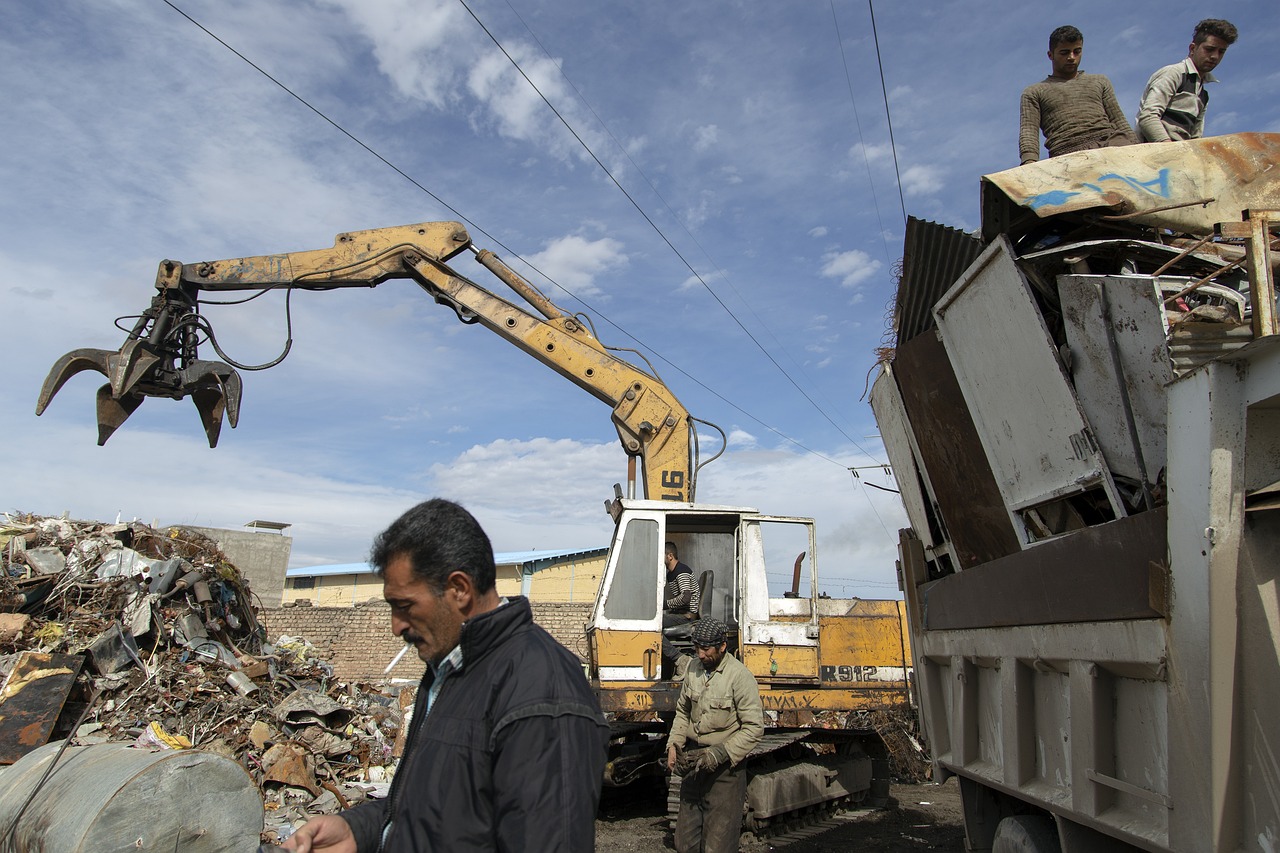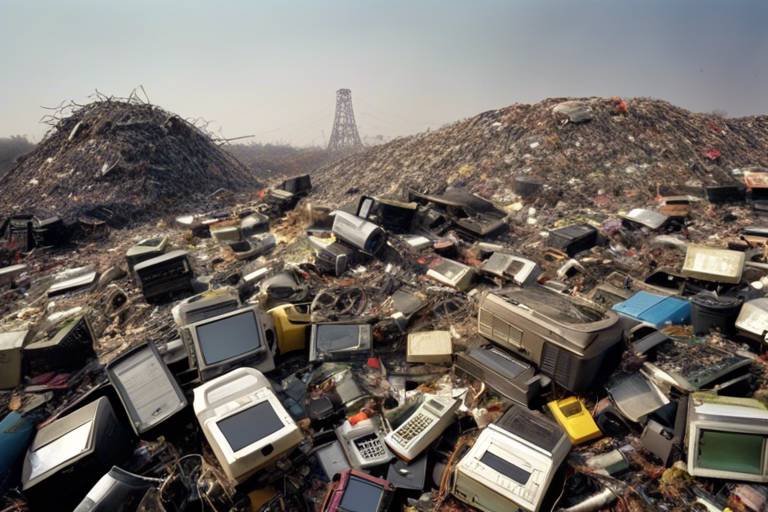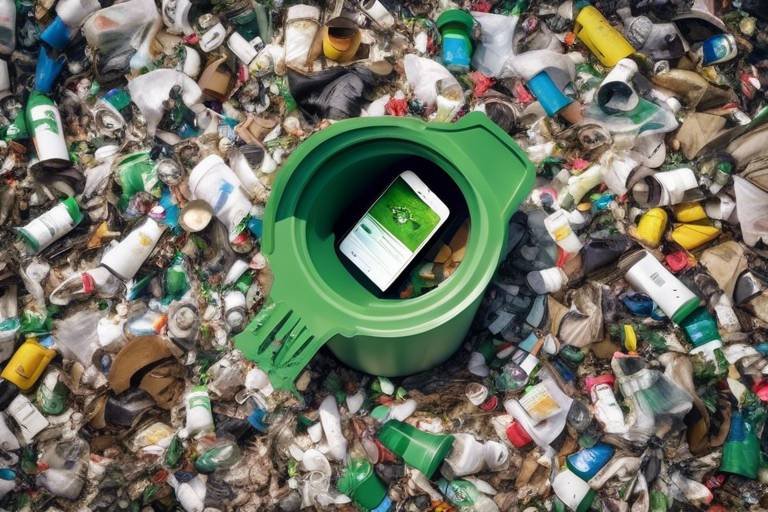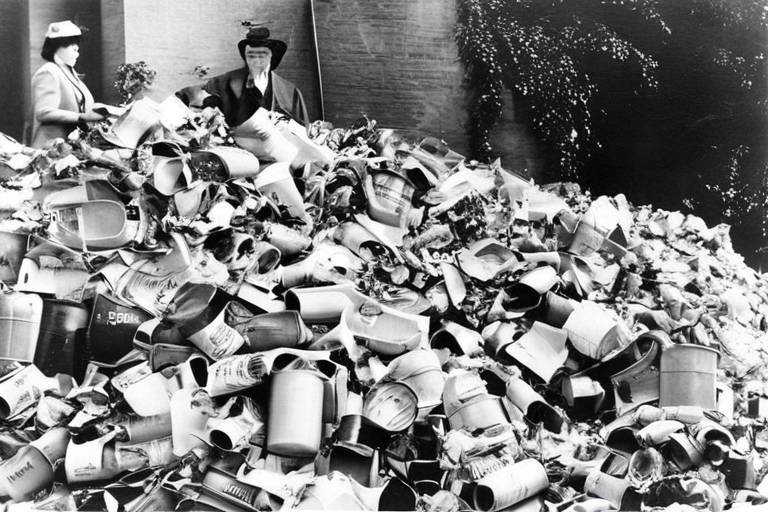Key Strategies for Implementing Zero Waste in Your Office
In today's world, where environmental concerns are at the forefront of global discussions, adopting a zero waste approach in your office is not just a trend; it's a necessity. Imagine walking into an office where every piece of paper, every plastic bottle, and every electronic gadget is given a second life. Sounds like a dream, right? Well, it doesn’t have to be! By implementing key strategies, you can transform your workplace into a model of sustainability and environmental responsibility. This article will guide you through effective methods to reduce waste generation, improve sustainability, and inspire a culture of eco-friendliness among your employees.
Before diving into the strategies, it’s essential to grasp the core principles of zero waste. At its heart, zero waste is all about minimizing waste through reducing, reusing, and recycling. Think of it as a cycle where materials are continuously utilized rather than discarded. The idea is to keep resources in use for as long as possible, extracting their maximum value before they turn into waste. This mindset not only helps in conserving natural resources but also reduces pollution and greenhouse gas emissions.
Now that you understand the principles, the next step is to conduct a waste audit. This process is crucial as it helps identify what materials are being discarded in your office. By understanding your waste composition, you can develop targeted strategies to reduce it. Start by gathering all waste produced over a week, categorize it, and analyze the results. This audit will serve as a foundation for your future waste reduction strategies.
Recognizing the main sources of waste in the office is vital. Common culprits include:
- Paper waste: This can come from unnecessary printing, packaging, or even takeout menus.
- Plastic waste: Think of all those single-use water bottles and coffee cups!
- Electronic waste: Old computers and phones that are no longer in use.
By pinpointing these sources, you can implement specific strategies to address them and enhance your waste management efforts.
Understanding the types of waste typically generated in offices will help you formulate effective reduction strategies. Here’s a breakdown:
| Type of Waste | Typical Sources | Reduction Strategies |
|---|---|---|
| Paper | Printouts, packaging | Digital documentation, double-sided printing |
| Plastics | Water bottles, food containers | Encourage reusable containers |
| Electronics | Old devices | Proper recycling programs |
Monitoring waste generation over time can reveal trends and areas for improvement. Utilize tools like spreadsheets or waste tracking software to keep an eye on your waste levels. Analyzing this data will help you identify patterns and implement more effective strategies moving forward.
Employee involvement is essential for the success of zero waste initiatives. To foster engagement, consider organizing workshops or informational sessions that highlight the importance of sustainability. Encourage employees to share their ideas and suggestions for reducing waste. Remember, when employees feel part of the solution, they’re more likely to commit to the cause!
Effective recycling programs are key to achieving zero waste goals. Establishing a recycling initiative requires careful planning and execution. Consider the types of materials you want to recycle and set up clearly labeled bins around the office. Make sure they are easily accessible to encourage participation.
Selecting appropriate recycling systems is vital for efficiency. Depending on your office size and layout, you might opt for:
- Single-stream recycling, where all recyclables are collected together.
- Source-separated recycling, where employees sort their recyclables at the source.
Choose a system that fits your office's needs and promotes ease of use.
Education is crucial for effective recycling. Conduct training sessions to inform employees about what can and cannot be recycled. Use posters and digital reminders to reinforce these practices. The more informed your staff is, the more likely they are to participate actively in recycling efforts.
A sustainable procurement policy supports zero waste goals by prioritizing environmentally friendly products. This involves evaluating suppliers based on their sustainability practices and choosing products that have minimal environmental impact. By doing this, you not only reduce waste but also contribute to a larger movement towards sustainability.
Assessing suppliers based on their sustainability practices can enhance procurement decisions. Look for suppliers that use recycled materials, have eco-friendly packaging, and demonstrate a commitment to reducing their own waste. This not only aligns with your zero waste goals but also sets a standard for your office.
Promoting reusable products can significantly reduce waste. Encourage employees to bring their own mugs, bottles, and lunch containers. Consider providing incentives or rewards for those who consistently choose reusable options. By fostering a culture of reuse, you’ll not only cut down on waste but also save money in the long run!
Q: What is zero waste?
A: Zero waste is a philosophy that aims to eliminate waste by encouraging practices such as reducing, reusing, and recycling materials.
Q: How can I get my office involved in zero waste initiatives?
A: Start by conducting a waste audit and engaging employees through workshops and training sessions to raise awareness about the importance of sustainability.
Q: What are some easy ways to reduce waste in the office?
A: Implement digital documentation to cut down on paper use, encourage reusable containers, and set up effective recycling programs.

Understanding Zero Waste Principles
This article explores effective strategies for adopting a zero waste approach in office environments, aiming to reduce waste generation, improve sustainability, and foster a culture of environmental responsibility among employees.
At its core, the concept of zero waste is about rethinking how we handle materials in our daily lives, especially in office settings. It’s not just about recycling; it’s a comprehensive approach that encourages us to minimize waste at every stage of a product's life cycle. The guiding principles of zero waste revolve around the mantra of reduce, reuse, and recycle. By focusing on these three areas, we can significantly lessen our environmental impact.
Let’s break down these principles:
- Reduce: This is the first and most critical step. It involves cutting down on the amount of waste we generate. In an office, this could mean opting for digital documents instead of printing, or choosing products with minimal packaging.
- Reuse: Before tossing something in the trash, consider if it can be repurposed. For instance, glass jars can be used to store office supplies, and old notebooks can be turned into scrap paper.
- Recycle: This is often the most recognized aspect of zero waste. However, it should be seen as a last resort after reducing and reusing. Setting up clear recycling stations in the office can help ensure that materials are properly sorted.
Moreover, zero waste isn’t just an individual effort; it requires a collective mindset. When everyone in the office commits to these principles, the impact can be profound. It’s about creating a culture where employees feel empowered to make sustainable choices. Think of it as a ripple effect: one small change can lead to a wave of positive environmental practices.
Another key aspect of zero waste is understanding the waste hierarchy. This hierarchy prioritizes actions based on their environmental impact, urging us to consider the best options first. The hierarchy can be summarized as follows:
| Rank | Action | Description |
|---|---|---|
| 1 | Refuse | Decline unnecessary items that contribute to waste. |
| 2 | Reduce | Minimize the amount of waste generated. |
| 3 | Reuse | Find new uses for items instead of discarding them. |
| 4 | Recycle | Process materials to make new products. |
| 5 | Compost | Turn organic waste into nutrient-rich soil. |
In summary, understanding and implementing zero waste principles is not just beneficial for the environment; it can also enhance office morale and productivity. When employees see their workplace taking concrete steps toward sustainability, they often feel more engaged and motivated. So, why not start today? Embrace the zero waste mindset and watch your office transform into a greener, more responsible space!
What is zero waste?
Zero waste is a philosophy that encourages the redesign of resource life cycles so that all products are reused, and waste is minimized.
How can my office start implementing zero waste practices?
Begin with a waste audit to understand your current waste generation, then educate employees on the principles of reduce, reuse, and recycle.
Is zero waste achievable for all offices?
While it may take time, many offices can significantly reduce their waste output by adopting zero waste practices.

Conducting a Waste Audit
Conducting a waste audit is a fundamental step in the journey toward achieving a zero waste office environment. Think of it as a health check-up for your office's waste management practices. Just as you wouldn’t skip a routine check-up for your health, you shouldn’t overlook the importance of understanding what waste your office generates. A waste audit not only helps identify what materials are being discarded but also serves as a crucial tool for informing future waste reduction strategies. By evaluating the types and quantities of waste produced, you can pinpoint areas ripe for improvement. So, how do you go about conducting an effective waste audit? Let’s break it down!
First, gather a team of enthusiastic employees who are willing to roll up their sleeves and dive into the data. It's essential to have a diverse group that represents different departments in your office. This way, you can get a comprehensive view of waste generation across various functions. Once your team is assembled, the next step is to set a timeline for the audit. A typical waste audit can span a week or even a month, depending on the size of your office and the volume of waste produced.
During the audit, you'll want to collect samples of waste from different areas of the office. This includes common areas like break rooms, meeting rooms, and individual workspaces. It might sound a bit daunting, but it’s crucial to be thorough. Use clear bags to separate waste into categories: recyclables, compostables, and landfill waste. After collecting the samples, it’s time to analyze the contents. This is where the magic happens! By sorting through the waste, you can identify patterns and trends. What types of materials are most frequently discarded? Are there items that could easily be reused or recycled?
| Waste Type | Estimated Weight (lbs) | Percentage of Total Waste |
|---|---|---|
| Paper | 150 | 30% |
| Plastics | 100 | 20% |
| Food Waste | 80 | 16% |
| Electronics | 50 | 10% |
| Other | 120 | 24% |
Once the data is collected and analyzed, it’s crucial to share the findings with the entire office. Transparency is key! Use this opportunity to educate employees about the volume and types of waste being generated. This not only raises awareness but also fosters a sense of responsibility among staff members. You might even consider creating a visual representation of the data, like charts or infographics, to make the information more digestible and engaging.
Finally, set specific goals based on your audit findings. For instance, if paper waste is a significant contributor, you might implement strategies to reduce paper usage, such as adopting digital documentation practices or encouraging double-sided printing. Remember, the ultimate goal is to create a culture of sustainability within your office. By regularly conducting waste audits and adjusting your strategies accordingly, you can make a significant impact on reducing waste generation and moving closer to a zero waste environment.
Q: How often should we conduct a waste audit?
A: It's recommended to conduct a waste audit at least once a year, but more frequent audits can help track progress and adapt strategies as needed.
Q: What tools do we need for a waste audit?
A: Basic tools include clear bags for sorting waste, scales for weighing, and data sheets for recording findings. You might also consider using software for data analysis.
Q: Can we involve all employees in the waste audit process?
A: Absolutely! Engaging employees not only helps with the audit but also boosts awareness and commitment to waste reduction initiatives.

Identifying Waste Sources
Identifying the sources of waste in your office is not just a good idea; it’s a crucial step towards achieving a zero waste environment. Think of it like a detective story where you need to uncover the hidden culprits that contribute to your waste problem. By pinpointing these sources, you can take targeted actions to reduce, reuse, and recycle more effectively. So, where do we start? Let's dive into some common areas that often generate waste in office settings.
First off, consider your paper usage. Offices are notorious for their reliance on paper, from printing documents to sticky notes and reports. According to statistics, the average office worker uses about 10,000 sheets of paper annually. That's a staggering amount! To tackle this, you might want to assess how many documents are printed unnecessarily or if digital alternatives could replace physical copies. Implementing digital signatures or using cloud storage can drastically reduce paper waste.
Next, let’s talk about plastic waste. This includes everything from plastic water bottles to packaging materials. Many offices still provide single-use plastics, which can accumulate quickly. A simple solution is to encourage employees to bring their own reusable water bottles and containers. You can even set up a fun challenge to see which department can generate the least plastic waste in a month!
Don't forget about electronic waste, often overlooked in waste audits. Outdated computers, printers, and other electronic devices not only take up space but also pose environmental hazards if not disposed of properly. An effective strategy here could be to establish a regular schedule for assessing and recycling electronic devices. Partnering with e-waste recycling companies can help ensure that these items are disposed of in an eco-friendly manner.
To make the process of identifying waste sources even more effective, consider conducting a waste audit. This involves collecting and analyzing the waste generated over a specific period to see what materials are most prevalent. You can categorize the waste into different types, such as:
- **Paper**: Reports, memos, and packaging
- **Plastics**: Bottles, wrappers, and containers
- **Electronics**: Old devices and accessories
- **Food waste**: Leftovers and packaging from lunches
By tracking these categories, you'll gain valuable insights into your office's waste generation patterns. This information can guide you in formulating specific strategies to reduce waste effectively. For instance, if food waste is a major contributor, you might consider implementing a composting program or encouraging employees to bring their own lunches in reusable containers.
In summary, identifying waste sources in your office is like shining a light on the shadows of wastefulness. By recognizing where waste is coming from, you can craft a tailored approach to mitigate it. Remember, every small change counts! As you embark on this journey, keep in mind that engaging your team in discussions about waste sources can foster a sense of shared responsibility, making the transition to a zero waste office not just a goal, but a collective mission.
Q: What are the most common sources of waste in an office?
A: The most common sources include paper, plastics, electronics, and food waste. Identifying these sources is key to implementing effective waste reduction strategies.
Q: How can we reduce paper waste in the office?
A: You can reduce paper waste by encouraging digital documentation, using double-sided printing, and implementing a paperless policy for certain processes.
Q: What should we do with old electronic devices?
A: Old electronic devices should be recycled through certified e-waste recycling programs to ensure they are disposed of safely and responsibly.
Q: How can we engage employees in waste reduction efforts?
A: Engage employees by hosting workshops, creating challenges, and recognizing departments that excel in waste reduction. Building a culture of sustainability requires everyone’s involvement!

Common Office Waste Types
In any office environment, waste is an inevitable byproduct of daily operations. However, understanding the common types of waste generated can significantly aid in crafting effective strategies for reduction. The most prevalent categories of office waste include paper waste, plastic waste, and electronic waste, each posing unique challenges and opportunities for sustainability.
Let’s delve deeper into these waste types to uncover their implications and potential solutions. First up is paper waste. Despite the digital age we live in, paper remains a staple in most offices. From memos to reports, the volume of paper used can be staggering. According to studies, the average office worker uses about 10,000 sheets of paper per year, leading to a significant environmental footprint. To combat this, organizations can encourage practices like double-sided printing, digital documentation, and even implementing a paperless policy where feasible.
Next, we have plastic waste, which often sneaks into our offices in the form of single-use items such as water bottles, coffee cups, and plastic utensils. These items not only contribute to landfill overflow but also take hundreds of years to decompose. A simple yet effective strategy to tackle plastic waste is to promote the use of reusable products. For instance, providing employees with branded reusable water bottles and coffee mugs can drastically cut down on single-use plastics. Additionally, setting up a system for recycling plastics can help manage what is inevitably used.
Lastly, let’s talk about electronic waste, often referred to as e-waste. With technology evolving at a breakneck pace, outdated electronics such as computers, printers, and phones accumulate quickly. E-waste is particularly problematic because it can contain hazardous materials that can leach into the environment if not disposed of properly. To mitigate this issue, offices should establish a clear e-waste recycling program, ensuring that old electronics are disposed of responsibly. This might include partnering with certified e-waste recyclers who can safely handle and recycle these materials.
To summarize, recognizing these common office waste types is the first step towards a more sustainable workplace. By taking proactive measures to reduce paper, plastic, and electronic waste, offices can significantly lower their environmental impact. Here’s a quick overview in table format:
| Type of Waste | Examples | Reduction Strategies |
|---|---|---|
| Paper Waste | Memos, reports, printouts | Double-sided printing, digital documentation |
| Plastic Waste | Water bottles, coffee cups, utensils | Use of reusable products, recycling programs |
| Electronic Waste | Old computers, printers, phones | E-waste recycling programs |
Ultimately, the goal is to foster a culture of sustainability within the office, where reducing waste becomes a collective effort. By addressing these common waste types head-on, organizations can not only contribute to a healthier planet but also inspire their employees to adopt more environmentally friendly practices in their personal lives.
Q1: What is the most effective way to reduce paper waste in the office?
A1: Implementing a paperless policy, encouraging digital documentation, and promoting double-sided printing can significantly reduce paper waste.
Q2: How can we encourage employees to use reusable products?
A2: Providing branded reusable items, such as water bottles and coffee mugs, along with educational campaigns about the benefits of reducing single-use plastics can encourage this behavior.
Q3: What should we do with old electronics?
A3: Establish an e-waste recycling program that partners with certified recyclers to ensure safe and responsible disposal of outdated electronics.

Tracking Waste Generation
Tracking waste generation in your office is like keeping a pulse on your environmental impact; it’s essential for understanding how much waste you produce and identifying areas for improvement. By monitoring the types and quantities of waste being generated, you can uncover trends that reveal not just how much you’re throwing away, but also how you can change your habits to foster a more sustainable environment. Imagine your office as a garden: if you don’t keep track of what’s growing, you might end up with weeds choking out the beautiful flowers. Similarly, without tracking waste, you might miss opportunities to cultivate a greener workplace.
One effective method for tracking waste is to establish a consistent monitoring schedule. This could be weekly, monthly, or quarterly, depending on your office's size and waste volume. During these audits, you can categorize the waste into different types, such as paper, plastics, food waste, and electronic waste. Keeping a detailed log of these categories will help you visualize the data and understand which areas need the most attention. For instance, if you notice that paper waste is consistently high, it might be time to implement a more robust digital documentation system.
To make this process easier, consider using a simple table to track your waste generation over time. Here’s an example of how you might structure it:
| Month | Paper Waste (lbs) | Plastic Waste (lbs) | Food Waste (lbs) | Electronic Waste (lbs) |
|---|---|---|---|---|
| January | 150 | 60 | 40 | 10 |
| February | 120 | 50 | 30 | 5 |
| March | 100 | 40 | 20 | 8 |
As you fill out this table each month, you’ll begin to see patterns emerge. Are there certain months where your waste spikes? Do specific events or activities correlate with increases in waste? This data is invaluable for making informed decisions about future waste reduction strategies.
Additionally, consider using digital tools or apps designed for waste tracking. These tools can help automate the process, making it easier to gather and analyze data. They can also provide visual representations of your waste generation, which can be more engaging for your team. Sharing these insights with your employees can foster a sense of accountability and encourage them to contribute to waste reduction efforts.
Ultimately, tracking waste generation is not just about collecting data; it’s about using that data to drive change. By understanding your waste profile, you can implement targeted strategies to reduce it, engage employees in sustainability efforts, and contribute to a healthier planet. Remember, every little bit counts, and even small changes can lead to significant impacts over time. So, roll up your sleeves, dive into the data, and watch your office transform into a beacon of sustainability!

Engaging Employees in Zero Waste Practices
When it comes to implementing a zero waste strategy in your office, one of the most significant factors for success is engaging your employees. After all, no matter how well-structured your plans are, they will only be as effective as the participation of your team. So, how do you get everyone on board? It’s all about creating a culture of sustainability that resonates with your coworkers. Start by communicating the importance of zero waste initiatives clearly. Explain how reducing waste not only benefits the environment but also enhances the workplace and can even save costs in the long run.
One effective way to engage employees is through interactive workshops and training sessions. These can be fun and informative, providing a platform for employees to learn about the zero waste philosophy, understand the impact of their actions, and discover practical steps they can take. Consider organizing monthly workshops where employees can share their experiences, challenges, and successes in reducing waste. This not only fosters camaraderie but also encourages a sense of ownership over the initiatives.
Moreover, you can create a zero waste team comprising enthusiastic employees who are passionate about sustainability. This team can lead projects, organize events, and serve as champions for zero waste practices. By empowering employees to take the initiative, you cultivate leadership and responsibility within your team. It can be incredibly motivating to see peers actively participating in these efforts, and it encourages others to join in.
Another effective strategy is to implement a reward system that recognizes and celebrates employees who contribute significantly to waste reduction. This could be in the form of monthly shout-outs, small prizes, or even a “Zero Waste Champion” title. Such recognition can motivate others to adopt similar behaviors, creating a ripple effect throughout the office.
In addition, consider introducing a visual tracking system that showcases the office's waste reduction progress. This could be a simple chart displayed in a common area, showing how much waste has been diverted from landfills over time. Seeing tangible results can be incredibly inspiring and can encourage everyone to stay committed to the cause. It’s like planting a seed of change and watching it grow into something beautiful.
Lastly, don’t forget to encourage open communication. Create channels for employees to share their thoughts, suggestions, and even frustrations regarding the zero waste efforts. This feedback can be invaluable in refining your strategies and ensuring that everyone feels included in the process. Remember, the more engaged your employees feel, the more likely they are to embrace zero waste practices wholeheartedly.
Q1: What is zero waste?
A: Zero waste is a philosophy aimed at minimizing waste by redesigning resource life cycles so that all products are reused. It emphasizes reducing, reusing, and recycling materials to create a closed-loop system.
Q2: How can I get my office to start a zero waste initiative?
A: Start by conducting a waste audit, engaging employees through workshops, forming a zero waste team, and creating a clear communication strategy about the goals and benefits of going zero waste.
Q3: What are some simple steps employees can take to reduce waste?
A: Employees can bring reusable containers for lunch, opt for digital documents instead of printing, use refillable pens, and participate in office recycling programs.
Q4: How can we measure the success of our zero waste initiatives?
A: You can track the amount of waste being generated and recycled over time, monitor employee participation in programs, and collect feedback to assess the overall impact of your strategies.

Implementing Recycling Programs
Implementing effective recycling programs is a cornerstone of achieving zero waste goals in any office environment. The process might seem daunting at first, but with the right strategies and commitment, your office can become a model of sustainability. Think of recycling as the bridge that connects waste generation to responsible waste management. It transforms what would otherwise be trash into valuable resources. But how do you create a program that not only works but thrives?
First, it's crucial to establish clear objectives for your recycling program. What do you want to achieve? This could range from reducing the amount of waste sent to landfills to increasing the percentage of materials being recycled. Setting measurable goals will help you track progress and motivate your team. For instance, you might aim to recycle 50% of your office waste within the first year. This gives everyone something to strive for and creates a sense of accountability.
Next, you need to choose the right recycling systems for your office. Not all recycling systems are created equal. Some offices might benefit from single-stream recycling, where all recyclables are placed in one bin, making it easier for employees to participate. Others might require a more segmented approach, where different materials—like paper, plastics, and metals—are separated. The choice often depends on the size of your office, the types of waste generated, and local recycling regulations. It's essential to assess your unique circumstances to determine the best fit.
Once you have a system in place, the next step is educating your staff on recycling practices. Education is pivotal; without it, even the best systems can fail. Consider hosting workshops or informational sessions that cover the basics of recycling, the importance of reducing waste, and how employees can contribute. You might even create a fun quiz or interactive game to test their knowledge and reinforce learning. Remember, the more engaged your employees feel, the more likely they are to participate actively in the program.
Additionally, creating visually appealing and informative signage can guide employees on what can and cannot be recycled. For example, a simple chart can clarify which items go into which bin. Here’s a sample table that could be used in your office:
| Item | Recycling Bin |
|---|---|
| Paper | Paper Bin |
| Plastic Bottles | Plastic Bin |
| Cans | Metal Bin |
| Food Waste | Compost Bin |
Moreover, consider implementing a rewards program to recognize employees who actively participate in recycling efforts. This could be as simple as a shout-out in a company meeting or as elaborate as a monthly prize for the most eco-conscious team. When employees see that their efforts are appreciated, it fosters a culture of sustainability and encourages others to get involved.
Lastly, don’t forget to monitor and evaluate the effectiveness of your recycling program regularly. Review the data on how much waste is being recycled versus how much is being thrown away. This analysis will provide insights into what’s working and what needs improvement. Perhaps some materials are being recycled more than others, or maybe there are common mistakes being made. By staying proactive, you can adapt your strategies and ensure that your recycling program continues to evolve and succeed.
1. What types of materials can be recycled in the office?
Most offices can recycle paper, cardboard, plastics, metals, and sometimes electronics. However, it’s essential to check local recycling guidelines for specific rules.
2. How can I encourage my coworkers to participate in the recycling program?
Education and engagement are key! Host workshops, create informative signage, and consider implementing a rewards system to motivate participation.
3. What should I do if my recycling program isn’t working?
Evaluate the program regularly. Gather feedback from employees, analyze waste data, and adjust your strategies as needed to improve participation and effectiveness.

Choosing the Right Recycling Systems
When it comes to implementing a successful zero waste strategy in your office, one of the most critical components is . It’s not just about placing a few bins around the office; it’s about creating a comprehensive system that makes recycling easy, efficient, and effective for everyone involved. Imagine trying to solve a jigsaw puzzle without knowing what the final picture looks like. You need the right pieces in the right places to complete the picture of sustainability.
To start, you should assess the specific needs of your office environment. Consider factors such as the size of your office, the types of materials typically used, and the volume of waste generated. This evaluation will guide you in selecting the most suitable recycling systems. For instance, a small office may benefit from a single-stream recycling system, where all recyclables are mixed together, while a larger office might require a more segmented approach to manage different types of materials effectively.
Here are some essential types of recycling systems to consider:
- Single-Stream Recycling: This system allows employees to place all recyclables—such as paper, plastics, and metals—into one bin. It simplifies the process, encouraging higher participation rates.
- Source Separation: In this method, different materials are separated at the source. This can lead to higher quality recyclables, but it requires more effort from employees.
- Composting Systems: If your office generates organic waste such as food scraps or plant materials, implementing a composting system can significantly reduce landfill contributions.
Moreover, it’s essential to ensure that the recycling bins are clearly labeled and strategically placed throughout the office. Think of it as setting up a treasure hunt; if the clues (or bins) are too hard to find or understand, participants may lose interest. Use bright colors and straightforward signage to make it easy for employees to identify what goes where. For example, you could have a blue bin for paper, a yellow one for plastics, and a green one for compost. This visual differentiation not only aids in proper disposal but also reinforces the recycling culture within the office.
Another aspect to consider is the frequency of collection. Depending on the volume of waste generated, you may need to adjust how often the recycling bins are emptied. Too infrequent collection can lead to overflow, which could discourage employees from using the bins properly. Regular collection schedules ensure that the recycling process remains seamless and encourages ongoing participation.
Finally, don’t forget about employee education on how to use these recycling systems effectively. Host workshops or create informative materials that explain the importance of recycling and how to do it correctly. When employees understand the impact of their actions, they’re more likely to engage in the recycling process. Consider creating a small table comparing the benefits of each recycling system you implement, which can serve as a quick reference for your staff:
| Recycling System | Benefits |
|---|---|
| Single-Stream Recycling | Simplifies the process, increases participation, and reduces contamination. |
| Source Separation | Higher quality recyclables, better for specific materials like glass and metals. |
| Composting Systems | Reduces organic waste, enriches soil, and promotes a circular economy. |
By carefully selecting and implementing the right recycling systems, you can create an office environment that not only minimizes waste but also promotes a culture of sustainability. Remember, this is a journey, and every small step counts towards a greener future.
Q: What is the most effective recycling system for a small office?
A: A single-stream recycling system is often the most effective for small offices as it simplifies the recycling process and encourages participation.
Q: How can I encourage employees to recycle more?
A: Educating your employees about the importance of recycling, providing clearly labeled bins, and creating a culture of sustainability can significantly boost participation.
Q: What should I do if my recycling bin is full?
A: Ensure that you have a regular collection schedule in place. If a bin is full, it may be necessary to contact your recycling provider for an additional pickup.

Educating Staff on Recycling Practices
When it comes to implementing a successful recycling program in your office, education is the cornerstone of success. Think of it like teaching someone to ride a bike; without proper guidance, they might wobble and fall. Similarly, without clear instructions on recycling, your staff may struggle to participate effectively. The goal here is to create an environment where recycling becomes second nature, a seamless part of the daily routine.
Start by organizing interactive workshops that not only inform but also engage employees. These workshops should cover the basics of recycling, such as what can be recycled, why recycling is important, and the environmental benefits of reducing waste. You could even include fun activities or competitions to spice things up! For instance, have a "recycling challenge" where teams compete to see who can recycle the most materials in a month. This not only educates but also fosters a sense of community and teamwork.
In addition to workshops, consider creating visual aids that can be placed around the office. Think posters or infographics that clearly outline recycling guidelines. These can serve as constant reminders for employees, making it easier for them to remember what goes where. For example, a simple chart showing the difference between recyclable and non-recyclable materials can be incredibly helpful. You might even include a table that outlines the recycling process for different materials:
| Material | Recycling Process | End Product |
|---|---|---|
| Paper | Collected, pulped, and cleaned | New paper products |
| Plastics | Sorted, cleaned, and melted | New plastic items |
| Glass | Crushed, melted, and molded | New glass containers |
Another effective strategy is to implement a mentorship program where more experienced employees guide newcomers on recycling practices. This peer-to-peer approach can be incredibly effective, as it allows for a more personalized learning experience. People often feel more comfortable asking questions and seeking clarification from their colleagues rather than from management.
Don’t forget about the power of regular feedback. Create a system where employees can share their thoughts on the recycling program and suggest improvements. This not only makes them feel involved but also helps you identify any gaps in knowledge or areas that need more focus. Remember, the goal is to create a culture of recycling, where every employee feels empowered to contribute.
Finally, celebrate successes! When your office reaches a recycling milestone, acknowledge it. This could be as simple as a shout-out in a meeting or as elaborate as an office-wide celebration. Recognizing efforts reinforces positive behavior and encourages continued participation in recycling initiatives.
Q: What materials can be recycled in the office?
A: Commonly recyclable materials include paper, cardboard, plastics (check local guidelines), glass, and metals. Always refer to your local recycling rules for specifics.
Q: How can I motivate my colleagues to recycle?
A: Organize engaging workshops, create visual aids, and foster a sense of community through challenges and mentorship programs. Celebrating milestones also helps!
Q: What if someone mistakenly puts non-recyclables in the recycling bin?
A: Use this as a learning opportunity! Provide gentle reminders and additional training to help everyone understand the correct practices.
Q: How can we track our recycling progress?
A: Keep records of the volume of materials recycled each month. You can also conduct regular audits to assess how well your program is performing.

Creating a Sustainable Procurement Policy
In the quest for a zero waste office, one of the most impactful steps you can take is to establish a sustainable procurement policy. This policy acts as a guiding light, steering your organization towards making environmentally conscious purchasing decisions. But what does this really mean? Essentially, it involves prioritizing products and services that are not only effective but also environmentally friendly. By adopting such a policy, you can significantly reduce the amount of waste generated in your office, while also supporting companies that share your commitment to sustainability.
To create an effective sustainable procurement policy, start by assessing your current purchasing practices. Ask yourself: are the products we buy made from sustainable materials? Do they have minimal packaging? Are they sourced from suppliers who prioritize eco-friendly practices? This reflection will help you identify areas where you can improve. It's like cleaning out your closet; once you see what you have, you can decide what to keep and what to replace with better options.
Next, consider developing a set of criteria for evaluating potential suppliers. This could include factors such as their use of renewable resources, waste management practices, and commitment to reducing carbon emissions. For instance, you might want to ask suppliers questions like:
- What materials are used in your products?
- How do you manage waste during production?
- What steps do you take to minimize your environmental impact?
By asking these questions, you can ensure that your procurement decisions align with your zero waste goals. Moreover, consider creating a supplier sustainability scorecard to compare different vendors based on their environmental practices. This scorecard can be a simple table that evaluates suppliers on various criteria, making it easier for you to choose partners who are committed to sustainability.
| Supplier Name | Material Sourcing | Waste Management | Carbon Footprint | Overall Score |
|---|---|---|---|---|
| Supplier A | Recycled Materials | Zero Waste Policy | Low | 9/10 |
| Supplier B | Biodegradable Products | Standard Practices | Medium | 7/10 |
| Supplier C | Conventional Materials | Poor | High | 3/10 |
In addition to evaluating suppliers, it’s essential to encourage the use of reusable products within your office. This can include everything from coffee mugs to office supplies. By fostering a culture that values reusables, you not only reduce waste but also promote a sense of responsibility among employees. For example, consider providing incentives for teams that adopt reusable options, such as discounts on office supplies or recognition in company meetings.
Finally, remember that a sustainable procurement policy is not just a one-time effort; it’s an ongoing commitment. Regularly review and update your policy to reflect changes in your organization’s goals, as well as advancements in sustainable products and practices. It’s like nurturing a plant; it needs regular care and attention to thrive. By staying proactive, you can ensure that your office continues to move towards a zero waste future.
1. What is a sustainable procurement policy?
A sustainable procurement policy is a framework that guides organizations in purchasing environmentally friendly products and services, aiming to reduce waste and promote sustainability.
2. How can I evaluate suppliers for sustainability?
You can evaluate suppliers by assessing their material sourcing, waste management practices, and overall commitment to reducing their environmental impact.
3. Why is it important to encourage reusable products in the office?
Encouraging reusable products helps to significantly reduce waste, fosters a culture of sustainability, and can lead to cost savings in the long run.
4. How often should I review my procurement policy?
It’s advisable to review your procurement policy at least annually, or whenever there are significant changes in your organization's goals or available sustainable products.

Evaluating Suppliers' Sustainability Practices
When it comes to implementing a zero waste strategy in your office, the role of suppliers cannot be overstated. After all, the products you purchase and the materials you use can significantly impact your overall waste generation. Therefore, should be a fundamental part of your procurement policy. But what exactly does this entail? It’s not just about picking the cheapest option; it’s about choosing partners who align with your environmental goals.
First and foremost, you need to consider the sustainability criteria that matter most to your organization. This could include factors such as the use of recycled materials, energy-efficient manufacturing processes, and ethical labor practices. For example, a supplier who prioritizes renewable energy in their production line not only reduces carbon emissions but also sets a precedent for sustainability in the supply chain. This is where having a clear list of your sustainability requirements comes into play. You might want to ask questions like:
- Do they use environmentally friendly packaging?
- What materials are their products made from?
- Are they certified by any recognized sustainability organizations?
Furthermore, engaging in conversations with potential suppliers can provide insights into their commitment to sustainability. During these discussions, don’t hesitate to ask for documentation or certifications that demonstrate their sustainable practices. This could include ISO 14001 certification for environmental management or any relevant sustainability reports. By doing this, you not only ensure that you are making informed decisions but also encourage suppliers to be more transparent about their practices.
To illustrate how you might evaluate suppliers, consider creating a simple evaluation table that outlines key sustainability metrics. Here’s a basic example:
| Supplier Name | Recycled Materials Used | Energy Source | Sustainability Certifications |
|---|---|---|---|
| Supplier A | Yes | Renewable | ISO 14001 |
| Supplier B | No | Fossil Fuels | None |
| Supplier C | Yes | Hybrid | LEED Certified |
This table not only helps you compare suppliers at a glance but also reinforces the importance of sustainability in your procurement process. Remember, the goal is to establish partnerships that reflect your commitment to a zero waste philosophy. By choosing suppliers who prioritize sustainability, you not only reduce waste but also inspire others in your industry to follow suit.
In summary, evaluating suppliers' sustainability practices is a crucial step in your journey toward a zero waste office. It requires diligence, transparency, and a commitment to understanding the broader impact of your purchasing decisions. By fostering these practices, you can create an office environment that not only minimizes waste but also champions sustainability at every level.
Q: Why is it important to evaluate suppliers' sustainability practices?
A: Evaluating suppliers' sustainability practices ensures that the products and materials you use align with your zero waste goals, ultimately reducing your environmental impact.
Q: What should I look for in a sustainable supplier?
A: Look for suppliers who use recycled materials, have energy-efficient processes, and hold recognized sustainability certifications.
Q: How can I encourage my suppliers to adopt more sustainable practices?
A: Engage in open discussions about sustainability, share your own goals, and consider incorporating sustainability criteria into your procurement policies.

Encouraging the Use of Reusable Products
In the quest for a zero waste office, one of the most impactful steps you can take is to encourage the use of reusable products. This doesn’t just reduce waste; it fosters a culture of sustainability within your workplace. Imagine walking into an office where everyone is sipping from their own stylish reusable water bottles instead of tossing away single-use plastic cups. It’s a small change, but it can lead to profound shifts in how employees think about waste and their environmental impact.
To kickstart this initiative, it’s essential to lead by example. When management actively uses and promotes reusable items, it sends a clear message about the importance of sustainability. Consider organizing a fun challenge where employees track their use of reusable products over a month. This could include everything from coffee mugs to shopping bags, and perhaps even a friendly competition with rewards for those who make the most significant impact. Not only does this create awareness, but it also builds camaraderie among employees.
Another effective strategy is to provide employees with incentives to switch to reusable options. For instance, you might offer discounts on coffee for those who bring their own mugs or set up a points system where employees earn rewards for using reusable containers. This not only encourages participation but also makes it a fun and engaging experience. Additionally, consider investing in high-quality reusable items, such as branded water bottles or tote bags, to give to employees as welcome gifts or prizes during team events.
Furthermore, education plays a crucial role in this transition. Many employees may not be fully aware of the environmental impact of single-use products. Hosting workshops or informational sessions can enlighten them about the benefits of reusables. You could even create a visual guide that outlines the types of reusable products available and their benefits. This guide could be displayed in common areas, serving as a constant reminder of the office’s commitment to sustainability.
Lastly, it’s important to address any barriers that may prevent employees from using reusable products. For instance, some may argue that they forget to bring their items or don’t have a place to store them. To counter this, consider providing designated storage areas for reusable items or setting up a reminder system, like calendar alerts. By removing these obstacles, you create a more supportive environment for adopting reusable practices.
In summary, encouraging the use of reusable products in the office is not just about reducing waste; it’s about creating a sustainable culture that employees can be proud of. By leading by example, offering incentives, educating staff, and addressing barriers, your office can significantly reduce its environmental footprint and inspire a community of eco-conscious individuals.
- What are some examples of reusable products? Reusable products include water bottles, coffee mugs, shopping bags, food containers, and utensils.
- How can I motivate my team to adopt reusable products? You can motivate your team by leading by example, offering incentives, and providing education about the benefits of reusables.
- What if employees forget to bring their reusable items? Consider providing designated storage areas for reusables and setting up reminders to help employees remember.
- Are there any costs associated with transitioning to reusable products? While there may be initial costs in providing items or incentives, the long-term savings on waste disposal and purchasing single-use products can outweigh these costs.
Frequently Asked Questions
- What is zero waste, and why is it important for offices?
Zero waste is a philosophy that encourages reducing waste to the bare minimum by rethinking how we manage resources. In an office setting, adopting zero waste practices is crucial because it not only helps the environment by reducing landfill contributions but also promotes a culture of sustainability among employees. Imagine your office as a living organism—when it operates efficiently, it thrives, benefiting everyone involved!
- How can I conduct a waste audit in my office?
Conducting a waste audit involves analyzing the types and amounts of waste generated over a specific period. Start by collecting waste samples, categorizing them (like paper, plastics, and electronics), and weighing each type. This data will help you identify major waste sources and develop targeted strategies to reduce them. Think of it as taking your office's health check-up—knowing where the problems lie is the first step to making improvements!
- What are some common sources of waste in offices?
Common sources of waste in offices include paper products, single-use plastics, food waste from break rooms, and outdated electronics. Recognizing these culprits is essential for effective waste management. By addressing these areas, you can significantly reduce the amount of waste your office generates. It’s like spotting the leaks in a boat—fixing them can keep you afloat!
- How can I engage my employees in zero waste initiatives?
Engaging employees in zero waste practices can be achieved through education, motivation, and creating a sense of ownership. Organize workshops, share success stories, and introduce friendly competitions to encourage participation. When employees feel involved, they are more likely to adopt sustainable habits. Think of it as rallying a team for a big game—everyone needs to be on board to score those sustainability goals!
- What are best practices for implementing recycling programs?
To implement effective recycling programs, start by assessing your office's needs and available resources. Choose appropriate recycling systems, clearly label bins, and ensure they are conveniently placed. Regularly educate staff on what can and cannot be recycled to maximize participation. It’s like setting up a treasure hunt—when the path is clear, everyone can join in the fun!
- How can I create a sustainable procurement policy?
Creating a sustainable procurement policy involves prioritizing environmentally friendly products and assessing suppliers based on their sustainability practices. Start by researching potential suppliers, asking about their eco-friendly initiatives, and choosing those that align with your zero waste goals. This policy is like a compass guiding your office towards greener choices—keeping you on the right track!
- What are the benefits of encouraging reusable products in the office?
Encouraging the use of reusable products significantly cuts down on waste, saves money, and promotes a culture of sustainability. By providing employees with reusable options, like water bottles and coffee mugs, you reduce reliance on single-use items. It’s akin to planting seeds in a garden—nurturing them leads to a flourishing environment for all!



















